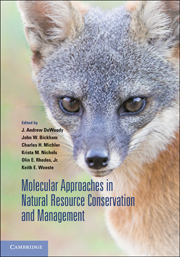Book contents
- Frontmatter
- Contents
- Contributors
- Preface
- 1 Biodiversity discovery and its importance to conservation
- 2 Gene flow, biodiversity, and genetically modified crops: Weedy rice in Thailand
- 3 A community and ecosystem genetics approach to conservation biology and management
- 4 Vertebrate sex-determining genes and their potential utility in conservation, with particular emphasis on fishes
- 5 Historical and contemporary dynamics of adaptive differentiation in European oaks
- 6 Association genetics, population genomics, and conservation: Revealing the genes underlying adaptation in natural populations of plants and animals
- 7 Hybridization in threatened and endangered animal taxa: Implications for conservation and management of biodiversity
- 8 Pollen and seed movement in disturbed tropical landscapes
- 9 Implications of landscape alteration for the conservation of genetic diversity of endangered species
- 10 Integrating evolutionary considerations into recovery planning for Pacific salmon
- 11 Using molecular methods to improve the genetic management of captive breeding programs for threatened species
- 12 Wildlife reintroductions: The conceptual development and application of theory
- 13 Evolutionary toxicology
- Index
- Plates
- References
10 - Integrating evolutionary considerations into recovery planning for Pacific salmon
Published online by Cambridge University Press: 05 July 2014
- Frontmatter
- Contents
- Contributors
- Preface
- 1 Biodiversity discovery and its importance to conservation
- 2 Gene flow, biodiversity, and genetically modified crops: Weedy rice in Thailand
- 3 A community and ecosystem genetics approach to conservation biology and management
- 4 Vertebrate sex-determining genes and their potential utility in conservation, with particular emphasis on fishes
- 5 Historical and contemporary dynamics of adaptive differentiation in European oaks
- 6 Association genetics, population genomics, and conservation: Revealing the genes underlying adaptation in natural populations of plants and animals
- 7 Hybridization in threatened and endangered animal taxa: Implications for conservation and management of biodiversity
- 8 Pollen and seed movement in disturbed tropical landscapes
- 9 Implications of landscape alteration for the conservation of genetic diversity of endangered species
- 10 Integrating evolutionary considerations into recovery planning for Pacific salmon
- 11 Using molecular methods to improve the genetic management of captive breeding programs for threatened species
- 12 Wildlife reintroductions: The conceptual development and application of theory
- 13 Evolutionary toxicology
- Index
- Plates
- References
Summary
Pacific salmon (see Table 10–1 for more information about terms in bold) enjoy iconic status in northwestern North America. As key components of both freshwater (Schindler et al. 2003) and marine (Beamish 2005) ecosystems, salmon play an important biological role in community structure and function. But salmon are no less crucial to the fabric of human societies. They have provided important food resources to Native Americans for at least 10,000 years (Butler & O'Connor 2004) and figure prominently in cultural, social, and economic traditions. Over the last ~200 years following European settlement, Pacific salmon have supported substantial commercial and sport fisheries, as well as continuing tribal harvest. Renowned for their long migrations and strong homing instinct, salmon have long been symbolic of Northwestern beauty and culture for human inhabitants of the region.
However, Pacific salmon also face a wide range of challenges to their persistence, due largely to major anthropogenic changes to their ecosystems (National Research Council 1996; Lackey et al. 2006). Urbanization, dams, road construction, harvesting, logging, mining, ranching, hatcheries, agriculture, invasive species, and other forms of habitat modification have all taken their toll on salmon populations. As a consequence, approximately 30% of historic salmon populations in the contiguous United States have been extirpated (Gustafson et al. 2007), and half of those that remain are formally protected under the U.S. Endangered Species Act (ESA) (Table 10–2).
- Type
- Chapter
- Information
- Publisher: Cambridge University PressPrint publication year: 2010
References
- 3
- Cited by



